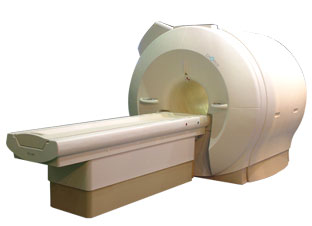 | Info
Sheets |
| | | | | | | | | | | | | | | | | | | | | | | | |
 | Out-
side |
| | | | |
|
| | | | |
Result : Searchterm 'Suppression' found in 7 terms [ ] and 42 definitions [ ] and 42 definitions [ ] ]
| previous 21 - 25 (of 49) nextResult Pages :  [1 2] [1 2]  [3 4 5 6 7 8 9 10] [3 4 5 6 7 8 9 10] |  | |  | Searchterm 'Suppression' was also found in the following services: | | | | |
|  |  |
| |
|
Quick Overview
Please note that there are different common names for this artifact.
NAME
Backfolding, foldover, phase wrapping, wrap around
DESCRIPTION
Image wrap around
Backfolding always occurs due to wrong phase encoding caused by objects outside the planned FOV. Phase encoding gradients are scaled for the field of view only. Tissues outside the FOV do not get properly phase encoded relative to their actual position and 'wraps' into the opposite side of the image.
The Backfolding artifact projects image contents which fall outside the imaging FOV back into the image; the back folded information thus reappearing on the other side of the image. In fact, information along the phase encoding direction can be viewed as projected onto a cylindrical screen with a circumference corresponding to the linear field of view dimension in the phase encoding direction.
See also Aliasing Artifact. | |  | | | |  Further Reading: Further Reading: | Basics:
|
|
| |
|  |  | Searchterm 'Suppression' was also found in the following services: | | | | |
|  | |  | |  |  |  |
| |
|
Quick Overview Please note that there are different common names for this artifact.
DESCRIPTION
Black contours at boundaries

Image Guidance
| |  | |
• View the DATABASE results for 'Black Boundary Artifact' (4).
| | | | |  Further Reading: Further Reading: | Basics:
|
|
| |
|  |  | Searchterm 'Suppression' was also found in the following services: | | | | |
|  |  |
| |
|

'Next generation MRI system 1.5T CHORUS developed by ISOL Technology is optimized for both clinical diagnostic imaging and for research development.
CHORUS offers the complete range of feature oriented advanced imaging techniques- for both clinical routine and research. The compact short bore magnet, the patient friendly design and the gradient technology make the innovation to new degree of perfection in magnetic resonance.'
Device Information and Specification
CLINICAL APPLICATION
Whole body
Spin Echo, Gradient Echo, Fast Spin Echo,
Inversion Recovery ( STIR, Fluid Attenuated Inversion Recovery), FLASH, FISP, PSIF, Turbo Flash ( MPRAGE ),TOF MR Angiography, Standard echo planar imaging package (SE-EPI, GE-EPI), Optional:
Advanced P.A. Imaging Package (up to 4 ch.), Advanced echo planar imaging package,
Single Shot and Diffusion Weighted EPI, IR/FLAIR EPI
STRENGTH
20 mT/m (Upto 27 mT/m)
| |  | |
• View the DATABASE results for 'CHORUS 1.5T™' (2).
| | | | |
|  |  | Searchterm 'Suppression' was also found in the following services: | | | | |
|  |  |
| |
|
| | | |  | |
• View the DATABASE results for 'Carr Purcell Meiboom Gill Sequence' (2).
| | | | |  Further Reading: Further Reading: | | Basics:
|
|
News & More:
| |
| |
|  | |  |  |
|  | |
|  | | |
|
| |
 | Look
Ups |
| |